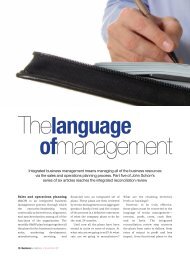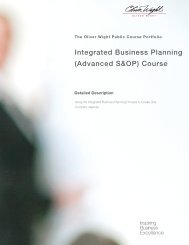Oliver Wight Caterpillar NACD Case - Oliver Wight Americas
Oliver Wight Caterpillar NACD Case - Oliver Wight Americas
Oliver Wight Caterpillar NACD Case - Oliver Wight Americas
You also want an ePaper? Increase the reach of your titles
YUMPU automatically turns print PDFs into web optimized ePapers that Google loves.
<strong>Caterpillar</strong> North American Commercial<br />
Highlights:<br />
• <strong>Caterpillar</strong>’s North American Commercial Division markets products<br />
from many plants and manages the company’s North American<br />
dealer network.<br />
• The division needed to coordinate its efforts more effectively with the<br />
manufacturing units on one side and independent dealers on the other.<br />
• Monthly Sales & Operations Planning meetings were introduced to<br />
help align team members on a commercial strategy and agree upon<br />
sales numbers.<br />
• Education and practice have enabled <strong>Caterpillar</strong> to achieve Class A,<br />
and 6 Sigma has begun to bring continuous improvement.<br />
• Confidence in <strong>NACD</strong>’s numbers enabled dealers to reduce inventory,<br />
while stabilizing product availability and reducing overall costs.<br />
As an industry leader, <strong>Caterpillar</strong> and its retail distribution network are continually<br />
under increasing competitive and cost pressures. Almost all its retail sales in<br />
North America are made through independent dealers. Since CAT covered 75%<br />
of the carrying cost of inventory, those dealers tended to overstock - carrying 3.5<br />
to 4 months of sales in inventory. This was expensive for CAT, and it exacerbated<br />
occasional inventory bubbles at CAT itself. The challenge was how to reduce<br />
unproductive cost, improve efficiency and not compromise customer service.<br />
With over $20 billion in sales and revenues, Fortune 100 company <strong>Caterpillar</strong><br />
manufactures its lines of construction and mining equipment in 48 plants in<br />
the U.S. and another 58 plants in 20 different countries. Its North American<br />
Commercial Division is responsible for distributing CAT products in markets<br />
that account for fully half of total sales. <strong>Caterpillar</strong> manages its decentralized<br />
and independent network of 63 U.S. and Canadian dealers and hundreds of<br />
locations with a single marketing organization: the North American Commercial<br />
Division. In effect, <strong>NACD</strong> is a wholesaler positioned between many of CAT’s<br />
factories and its retailers. However, the structure that CAT put in place inevitably<br />
made its internal communications and coordination more difficult than if each<br />
product line had an integral marketing team. <strong>NACD</strong> was the right structure<br />
in light of the established distribution network. But, it now needed to respond<br />
to competitive pressures - and to an important cost-control challenge.<br />
Approximately 10 years ago, <strong>Caterpillar</strong> reorganized the company into parallel<br />
business units: responsible for manufacturing, marketing and common business<br />
services. <strong>NACD</strong> discovered that this split made coordination with manufacturing<br />
more of a challenge.<br />
“When you break into a decentralized organization, people can get into silos,”<br />
said <strong>NACD</strong> S&OP Manager Dale Roberts, “They can easily forget about the<br />
overall company interests and concentrate on their own. So the issue becomes<br />
one of trying to balance those individual interests, which are constructive in<br />
many ways, and still keep everyone focused on the needs of the total company.”<br />
While this decentralized structure had worked well, there were pressing<br />
reasons to search for further improvement. Specifically, the group wanted to
















